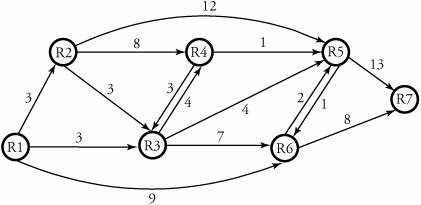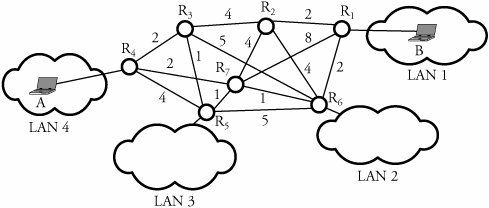Section 7.8. Exercises
| 1. | Consider a packet-switching network for server communications with n nodes. For each of the following topologies, sketch the network, and give the average number of hops between a pair of servers (include the server-to-node link as a hop):
|
| 2. | Figure 7.18 shows a network.
Figure 7.18. Exercises 24 network example |
| 3. | For the network shown in Figure 7.18:
|
| 4. | Consider again the network in Figure 7.18. Assume that each link is bidirectional and that the cost of either direction is identical.
|
| 5. | The network shown in Figure 7.19 is a snapshot of a practical consisting of seven routers. The load on each link is normalized to a number indicated on that link.
Figure 7.19. Exercises 56 network example |
| 6. | For the network shown in Figure 7.19:
|
| 7. | The practical network shown in Figure 7.20 is a WAN consisting of seven routers R 1 through R 7 interconnecting four LANs. The load on each link is normalized to a number indicated on that link. Assume that all links are bidirectional with equal indicated load.
Figure 7.20. Exercise 7 network example |
| 8. | The practical network shown in Figure 7.20 is a WAN consisting of seven routers R 1 through R 7 interconnecting four LANs. The load on each link is normalized to a number indicated on that link. Assume that all links are bidirectional with equal indicated load.
|
| 9. | The network in Figure 7.21 has six interconnected nodes, A through F. The corresponding blocking probabilities of links are indicated on the corresponding links. For this network, find the overall blocking probability from A to F. Figure 7.21. Exercise 8 network of links |
| 10. | Figure 7.22 shows a large communication network of six interconnected nodes, A through F. The corresponding blocking probabilities of links are indicated on the corresponding links. For this network, find the overall blocking probability from AtoF. Figure 7.22. Exercise 9 network of links |
| 11. | Computer simulation project . Write a computer program to simulate Dijkstra's algorithm for the seven-node network shown in Figure 7.20. Your program must
|
| 12. | Computer simulation project . Write a computer program to simulate the Bellman-Ford algorithm for the seven-node network shown in Figure 7.20. Your program must
|
EAN: 2147483647
Pages: 211




